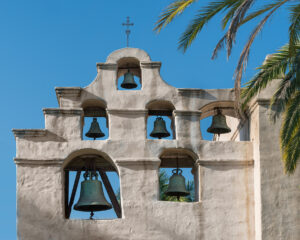The modern evolution of the Catholic exorcism
The modern evolution of the Catholic exorcism
In October 2020, protestors in California tore down a statue of Saint Junípero Serra, a Franciscan priest and friar criticised for his treatment of indigenous Americans. Within days, the archbishop of San Francisco visited the spot to perform an exorcism, a ritual designed to cast out and banish demons or evil spirits.[1]
While some might view the archbishop’s actions as a relic of a Catholicism of the past, they reflect a very real concern for a growing number of the world’s Christians. While those requesting exorcisms varies over the years, the latter half of the 2010s has seen a growing demand for the service[2]–– so much so that the International Association of Exorcists, a Vatican-backed organisation, declared the increasing requests a “pastoral emergency” in 2018.[3] In fact, some areas in France had so few priests capable and willing to perform exorcisms, that alleged victims have been forced to hire private individuals.[4] To help solve the growing problem, the Vatican held a course on exorcisms in 2018 to train a new generation of exorcists.[5]
Though exorcism practice has been around for generations in the Catholic Church, the material taught in 2018 advocated a newer, edited process, one designed to respond to recent advances in our understanding of mental health and to an interreligious pressure generated by the Pentecostalism movement.
History of Catholic exorcism
For centuries, exorcism in the Church consisted of a series of unorganised rules and practices, differing across time and geography. It was not until the aftermath of the Reformation, when the Catholic Church underwent extensive reform, that exorcism became formally codified.[6] In 1614, the Catholic Church released the Rituale Romanum, or Roman Ritual/Rites, which amongst other things, contained the script to be read by a priest during an exorcism. (Fun fact: a combination of the lines “Illius enim te urges potestas // imperat tibi majestas Christi/”[7] has entered pop culture through the 1973 film, The Exorcist, albeit in an English rendition as: “the power of Christ compels you”). The rites recorded in the Rituale persisted, unchanged, until 1999. The lack of edits is partially due to their decreased need as the popularity of exorcisms declined when Enlightenment ideas flourished in Europe from the 18th century onwards.[8] Instead of religion, more people turned to doctors and medicine for help with health problems, both physical and mental.
Exorcism in the 21st century
One of the major updates in the 1999 reworking of the Rituale Romanum was to distinguish between instances where there was a psychological problem and instances requiring an exorcism, a response to accusations that possessed individuals are really just people struggling with mental disorders.[9] Many priests will only proceed with an exorcism after a psychologist has accessed the situation and ruled out an underlying psychological disorder. Even then, priests perform an exorcism as a last resort, with some noting that less than ten percent of cases of possession result in an exorcism.[10] Despite these changes, critics maintain that the process still leads to abuse, with hard-to-diagnose epileptic or schizophrenic patients being wrongfully labelled as possessed.[11]
These criticisms are not altogether unfounded, as there have been incidents, albeit rare, of death or extreme trauma occurring during the exorcism process, particularly when the participant is unwillingly forced to participate.[12] [13] Many of these exorcisms, however, are not officially supported by the Catholic Church, which treats the process with great seriousness, having numerous requirements that must be met in order to carry out the procedure.[14]
Pentecostalism and interreligious influences
While concerns about mental health dominated the content of the 1999 and subsequent changes by the Church, an additional factor served as a motivator for change: religious pressure. As the practice of exorcism faded to more of a memory in the Catholic Church, it became a focal point for a newly developing Christian sect: Pentecostalism. Since its origins in the 19th century, Pentecostalism has become the fastest-growing sect, with some estimates averaging around 35,000 new converts daily.[15] Members believe that humans can have a personal relationship with God, often through the earthly intervention of the Holy Spirit. A component of this relationship and a frequent Pentecostalist healing ritual takes the form of casting out demons and bad spirits, with the help of the Holy Spirit. Many have left the Catholic Church and become Pentecostalists with a desire to tap into these procedures.
In response, Catholic priests, particularly in South America and Africa, have started to form their own exorcism organisations, with some even mimicking large-scale Pentecostalist healing ceremonies.[16] Pope Francis, who has spent most of his life in South America, has brought a strong belief in the ill deeds of Satan and demonic forces to the papacy. Some have even claimed that the pope publicly performed an informal exorcism in 2013, when he placed his hands on the head of an allegedly possessed visitor, who proceeded to shake violently then relax. Observers, including some Church officials, called it an exorcism, though the Vatican later released a statement claiming that had not been the case.[17] [18]
Exorcism in Europe today: need for trained priests
The increase in exorcisms is not isolated to just the global south. Europe has seen a large number of requests for exorcisms over the past decade. In France there are not enough priests to meet the need, leading to the hiring of private individuals who can charge substantial sums;[19] in Italy there are allegedly 500,000 individuals seeking an exorcism every year; and requests for exorcisms have risen in the UK.[20]
With a growing demand, the Catholic Church has begun attempting to train more priests to carry out exorcisms. Certain archdioceses, like Chicago and Sicily, have already created courses and, as mentioned above, the Vatican held a training course in 2018.[21] Some within the Church are worried that a suitable number of younger priests will not be trained, as the role can be controversial – given the mental health complications – and involves extensive, tiring work in a windowless room for much of one’s time.[22] Regardless of how the Church will fill the gap, the steps to train a future generation of exorcists serves as a reminder that just as stories of exorcism continuously crop up in the entertainment world, so too do calls for spiritual exorcism in the religious world.
Learn more about religion and society on the EARS Dashboard.
[1] San Francisco archbishop performs exorcism at site of destroyed St. Junipero Serra statue
[2] Demand for exorcists is soaring in France
[3] Vatican to hold exorcist training course after ‘rise in possessions’
[4] Demand for exorcists is soaring in France
[5] Exorcism: Vatican course opens doors to 250 priests
[6] Driving out the evil: What’s behind the exorcism boom?
[7] Rituale Romanum
[8] Driving out the evil: What’s behind the exorcism boom?
[9] Exorcism: Vatican course opens doors to 250 priests
[10] Exorcism: Vatican course opens doors to 250 priests
[11] Exorcism: Vatican course opens doors to 250 priests
[12] The ‘exorcism’ that turned into murder
[13] ‘Like being raped’: three claims of coerced exorcism in the UK
[14] Exorcisme Accueil, écoute et discernement
[15] Atlas of Pentecostalism
[16] Driving out the evil: What’s behind the exorcism boom?
[17] Pope Francis’ Informal Exorcism, Latin American Style
[18] Vatican denies Pope Francis performed ‘exorcism’
[19] Demand for exorcists is soaring in France
[20] Exorcism: Vatican course opens doors to 250 priests
[21] Exorcism: Vatican course opens doors to 250 priests
[22] Exorcism in Italy a job ‘too scary’ for young priests






